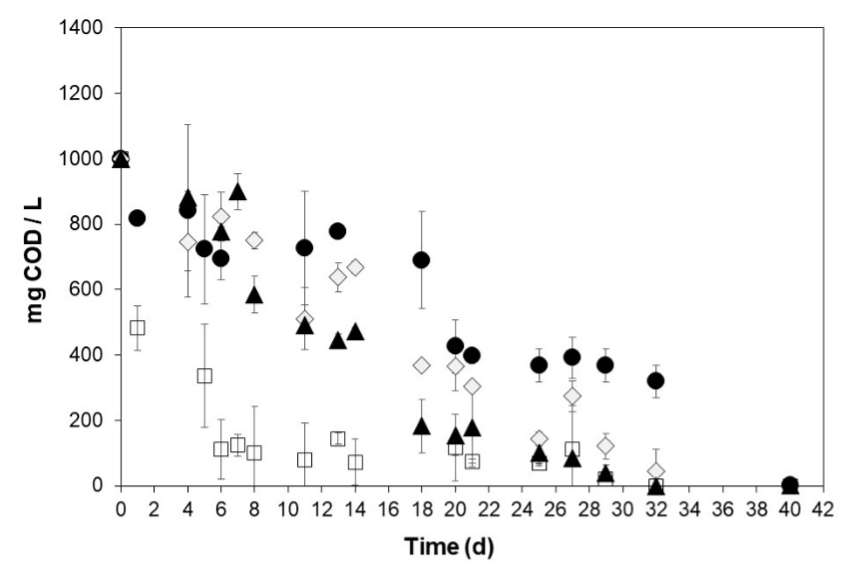- Aguirre-Garrido, J. F., Ramírez-Saad, H. C., Toro, N. and Martínez-Abarca, F. (2016). Bacterial diversity in the soda saline crater lake from Isabel Island, Mexico. Microbial Ecology 71, 68–77. https://doi.org/10.1007/s00248-015-0676-6
- Ali, N., Gong, H., Liu, X., Giwa, A. S. and Wang, K. (2020). Evaluation of bacterial association in methane generation pathways of an anaerobic digesting sludge via metagenomic sequencing. Archives of Microbiology 202, 31–41. DOI: 10.1007/s00203-019-01716-x
- APHA, 2005. Standard Methods of Water and Wastewater. 21st Edn., American Public Health Association, Washington, DC., ISBN: 0875530478, pp: 2-61.
- Ariesyady, H. D., Ito, T. and Okabe, S. (2007). Functional bacterial and archaeal community structures of major trophic groups in a full-scale anaerobic sludge digester. Water Research 41, 1554–1568. DOI: 10.1016/j.watres.2006.12.036
- Barceló-Quintal, I.D., B. Q., Salazar-Pelaez, M.L., García-Albortante, J., A., Domínguez-Mariani, E., López-Chuken, U.J. and Gómez-Salazar S. (2013). Evaluation of water quality index in Lerma River upper basin. Journal of Environmental Protection 2013. DOI:10.4236/jep.2013.47A012
- Carreño, C., Zarazúa, G., Fall, C., Ávila-Pérez, P. and Tejeda, S. (2018). Evaluación de la toxicidad de los sedimentos del curso alto del río lerma, México. Revista Internacional de Contaminación Ambiental 34, 117–126. https://doi.org/10.20937/RICA.2018.34.01.1
- Fernández, N., Díaz, E. E., Amils, R. and Sanz, J. L. (2008). Analysis of microbial community during biofilm development in an anaerobic wastewater treatment reactor. Microbial Ecology 56, 121–132. DOI: 10.1007/s00248-007-9330-2
- González-Blanco, G., Valencia-Nava, A., Beristain-Cardoso, R., Hernández-Jaimes, C., Orozco-Villafuerte, J., & Buendía-González, L. (2017). Anammox activity of sludge coming from wetland monocots (Typha sp.): kinetic study. Revista Mexicana de Ingeniería Química 16, 555–561. http://www.redalyc.org/articulo.oa?id=62052087020
- Hernández-Mendoza, H., Ríos-Lugo, M. J., Romero-Guzmán, E. T., Reyes-Gutiérrez, L. R. and Ketterer, M.E. (2018). Heavy metals monitoring in sediments from Lerma River in West-Central Mexico. American Journal of Analytical Chemistry 9, 77-87. DOI: 10.4236/ajac.2018.92007
- Liang, R., Duncan, K. E., Le Borgne, S., Davidova, I., Yakimov, M. M. and Suflita, J. M. (2017). Microbial activities in hydrocarbon-laden wastewaters: impact on diesel fuel stability and the biocorrosion of carbon steel. Journal of Biotechnology 256, 68–75. https://doi.org/10.1016/j.jbiotec.2017.02.021
- Mora, A., García-Gamboa, M., Sánchez-Luna, M. S., Gloria-García, L., Cervantes-Avilés, P. and Mahlknecht, J. (2021). A review of the current environmental status and human health implications of one of the most polluted rivers of Mexico: The Atoyac River, Puebla. Science of the Total Environment 782, 146788. https://doi.org/10.1016/j.scitotenv.2021.146788
- Owen, W. F., Stuckey, D. C., Healy Jr, J. B., Young, L. Y. and McCarty, P. L. (1979). Bioassay for monitoring biochemical methane potential and anaerobic toxicity. Water Research 13, 485–492. https://doi.org/10.1016/0043-1354(79)90043-5
- Romualdo-Martínez, I. V., Hernández-Rodríguez, A. I., González-Blanco, G. and Beristain-Cardoso, R. (2022). Metabolic and kinetic changes of activated sludge because of failures in the aeration system in a WWTP. Revista Mexicana de Ingeniería Química 21, IA2914–IA2914. https://doi.org/10.24275/rmiq/IA2914
- Salinas Tapia, H., Flores Gutiérrez, L., García Aragón, J. A., Tejeda, S. and López Rebollar, B. (2015). Modelación del curso alto del río lerma (carl), utilizando qual2kw, considerando la distribución y variación de nitrógeno amoniacal y nitrógeno como nitratos. Aqua.LAC 8, 34–43. DOI: 10.29104/phi-aqualac/2016-v8-1-04
- Schloss, P. D., Westcott, S. L., Ryabin, T., Hall, J. R., Hartmann, M., Hollister, E. B... and Weber, C.F. (2009). Introducing mothur: open-source, platform-independent, community-supported software for describing and comparing microbial communities. Applied and Environmental Microbiology, 75, 7537–7541. DOI: 10.1128/AEM.01541-09
- Tabatabaei, M., Rahim, R. A., Abdullah, N., Wright, A. D. G., Shirai, Y., Sakai, K... and Hassan, M. A. (2010). Importance of the methanogenic archaea populations in anaerobic wastewater treatments. Process Biochemistry 45, 1214–1225. https://doi.org/10.1016/j.procbio.2010.05.017
- Traversi, D., Villa, S., Lorenzi, E., Degan, R. and Gilli, G. (2012). Application of a real-time qPCR method to measure the methanogen concentration during anaerobic digestion as an indicator of biogas production capacity. Journal of Environmental Management 111, 173–177. DOI: 10.1016/j.jenvman.2012.07.021
- Wang, Q., Garrity, G. M., Tiedje, J. M. and Cole, J. R. (2007). Naive Bayesian classifier for rapid assignment of rRNA sequences into the new bacterial taxonomy. Applied and Environmental Microbiology 73, 5261–5267. DOI: 10.1128/AEM.00062-07
- Yu, Z., Wen, X., Xu, M., & Huang, X. (2012). Characteristics of extracellular polymeric substances and bacterial communities in an anaerobic membrane bioreactor coupled with online ultrasound equipment. Bioresource Technology 117, 333–340. https://doi.org/10.1016/j.biortech.2012.04.075
|

